●Library @ Monash University
●8月27日(土曜日)(はやし浩司 2011-08ー27)
++++++++++++++++++
旅の疲れが出たのか?
それとも運動のせいか?
今日も、2時間も昼寝をした。
それなりにぐっすりと眠った。
目覚めも悪くなかった。
が、寝起きに夢を見た。
しばらく、ぼんやりしていた。
その夢について、あれこれと考えていた。
しかし夢は夢。
頭から振り切ると、そのまま起きあがった。
足下がフラフラした。
台所へ行くと、
ワイフが、そこにいた。
「2時間も眠ったみたい」と声をかけると、
「よく寝たわね」と。
++++++++++++++++++
●運動
昨日は、(今朝も)、朝起きると、ウォーキングマシンの上で、30分、歩いた。
マシンでは、30分が、MAX(=限度)になっている。
が、30分程度がよい。
20分を過ぎるころから呼吸が激しくなり、さわやかな汗が全身を流れ始める。
ほかに昨日の午後は、サイクリングを2単位。
1単位は、30~40分前後。
ほどよい疲れが、心地よかった。
●Kさん
40年来の友人に、Kさんという人がいる。
私と同じ、昭和22年(1947)生まれ。
役所を退職したあと、3反(900坪)の畑を買い求め、今は「百姓」(Kさん弁)をしている。
そのKさんは、無農薬農業を心がけている。
「無農薬農業」といっても、実際には、不可能。
数年もかけて、ミカンの木を栽培したが、カミキリムシが入り、全滅。
海水をくんできて、それで消毒していたが、あまり効果はなかったという。
今は、野菜作りに専念している。
そのKさんに、ニンニクを分けてもらえないかと、昨夜電話をかけた。
東北産も中国産も、安心できない。
そこでKさんに助けを求めた。
が、この暑さ。
できは、よくないとのこと。
そしてこうも言った。
「あと何年かすると、この日本では野菜作りもできなくなるかもしれないね」と。
気候が温暖化すると、野菜もできなくなるという。
言い忘れたが、Kさんは東京農大を出た、エリート中のエリート。
役所でも、その道、一筋に生きてきた人である。
そのKさんが、そう言った。
●総入れ歯
K「林さん(=私)、私ね、総入れ歯になりましたよ」
私「総入れ歯?」
K「昔から虫歯だらけでね。それで歯周炎に苦しみました。で、歯がみんな抜けてしまって……」
私「……!」
K「明日、その入れ歯を入れてもらうことになっています。話していても、フニャフニャします。聞きづらいでしょう?」と。
その話を聞いて、ツンとしたさみしさが、私の心を包んだ。
Kさんだけではない。
こうして私たちは、老いていく。
老い方は、人それぞれだが、みな、例外なく老いていく。
私「私も、しばらく同じ姿勢をつづけていると、体が固まって、動けなくなくなります」
K「あら、それはいけないな」
私「正座なんか、もう私にはできません。10分もしただけで、歩けなくなります」
K「ハハ、ぼくもね、腰が弱くて、映画館で映画を観ることができませんよ」
私「どうして?」
K「映画館で映画を観ていると、腰が痛くなります。太りすぎです」
私「それも、いけないですね」と。
ニンニクの話をするつもりだったが、健康の話になってしまった。
私の年代の人たちは、みな、そうなる。
最後には、結局は健康の話になる。
●夏のレッスン
今日は土曜日だったが、レッスンをひとつこなしてきた。
「夏期講座」と呼んでいる。
このレッスンを通して、子どもたちに自信をつけさせる。
それを第一のテーマにしている。
何かを教えるのではなく、自信をもたせる。
そんな目的を、このビデオを通して、理解してもらえれば、うれしい。
Hiroshi Hayashi++++++はやし浩司
【Summer Lesson @ BW Children's Club Hamamatsu Japan Aug. 27th 2011】
(1)
(2)
(3)
(4)
Hiroshi Hayashi++++++Aug. 2011++++++はやし浩司・林浩司
●残暑
残暑もきびしいが、朝夕は、めっきり涼しくなった。
ときに寒いほど。
このところ風邪をひく人が多くなった。
そんな話をよく耳にする。
実は私も、あぶなかった。
寝る前はそれなりに暑い。
が、夜中に、急に気温がさがる。
それで風邪をひく。
今朝もそうだった。
それに気がつき、ワイフにしがみついていった。
●職業観
1970年のころのこと。
今は、どうか、知らない。
当時のオーストラリアでは、大卒の資格がないと、ユンボやブルドーザーを操作できなかった。
それだけその仕事は、技術職として重要視されていた。
一方、私たち、団塊の世代にとっては、商社マン、証券マンというのは、それなりの職業だった。
私たちが大学を卒業するころ、日本は高度成長の波に乗った。
すべてがマネー、マネーという時代だった。
が、その時代は、あの山一証券の倒産劇で、終わった。
つまり「それなりの職業」という幻想が、つぶれた。
ほかの世代の人たちには、それがわからないかもしれない。
しかし社長が、テレビカメラに向かって、「私が悪いんです。みんな私が悪いんです」と泣きじゃくって見せたとき、その幻想は、つぶれた。
私たち団塊の世代に与えた衝撃は、大きかった。
が、一方、オーストラリアでは、日本の商社マンは、「軽蔑」されていた。
軽蔑ということは、軽蔑。
どう軽蔑されていたかについては、すでに何度も書いた。
つまり私たちがもっている「職業観」というのは、国によってちがう。
たとえば「軍事国家」「独裁国家」と呼ばれている国々では、軍人がエリートということになっている。
現在のフィリッピンがそう。
北朝鮮もそう。
戦時中の日本も、そうだった。
弁護士にしても、アメリカでは、資格をもちながら、失業している人はゴマンといる。
さらに言えば、パイロット。
日本航空のばあい、ほんの4、5年前までは、機長といえば、年収2400万円以上。
しかしアメリカでは、国際線の機長ですら、月収12万円前後(「超大恐慌の時代」)で飛んでいる。
しかも雇用契約は、一年ごとの更新制。
多くの国では、空軍のパイロットが転職し、民間機のパイロットになるケースが多い。
が、ここにきて、全裸の機長が、女性の下着を盗みに入り、逮捕されるという事件が起きた(2011年8月)。
日本航空の現役の機長だったというから、驚きである。
つまりそういう頭のおかしな人が、飛行機の中で、操縦かんを握っていた!
想像するだけで、ゾッとする。
地に落ちた・・・というか、こうして私たちがもっている幻想は、つぶれていく。
というか、職業に上下はない。
あるはずもない。
が、日本には、江戸時代の身分制度が、いまだに残っている。
身分制度そのものは崩れたが、その「意識」が残っている。
その意識でもって、職業の上下を判断する。
それが今、音をたてて崩れ始めている。
●学歴制度の崩壊
もう7、8年前の話だから、現在の実情とは違っているかもしれない。
しかしこんな話を、ある中学校の校長(浜北区H中学校)の校長から聞いた。
「今では、60%の中学生は、受験勉強などしていません。部活でがんばって、推薦で高校へ入ると考えています」と。
それから7、8年。
60%より多くなったのか。
それとも少なくなったのか。
が、一度緩んだバネは、もとには戻らない。
中学生ですら、意識が変わった。
高校生も、変わった。
大学生も、変わった。
変わらないのは、40代以上の古い世代。
中には、60歳になっても、70歳になっても、過去の学歴を頭に載せて歩いている人さえいる。
それはそれとして、こうした変化も時代の流れ(?)。
が、これは同時に深刻な問題でもある。
学問の軽視は、そのまま学力の低下につながる。
先日もこんなことがあった。
事務機器屋の男に、背の高い本箱を据え付けてもらった。
そのとき私が、「地震のとき倒れるから心配だ」と言ったら、その男(40歳くらい)は、こう言った。
「この本箱(スチール製)は、重いから、倒れませんよ」と。
私がいう「学力」というのは、それをいう。
学力のない人は、平気で、そう言ったりする。
こんな国が、これから先、どうやって外国と戦っていくというのか。
●学ぶ力
繰り返し書く。
(もの知り)と(思考)は、まったく別のもの。
ものをよく知っている=情報量が多いからといって、賢い人ということにはならない。
利口な人かもしれないが、賢い人ではない。
たとえば幼稚園児でも、掛け算の九九を暗記している子どもがいる。
だからといって、そういう子どもをさして、「賢い子ども」とは、言わない。
昔、宮沢俊義という憲法学者がいた。
私が法学生のころには、神様のような存在だった。
その宮沢俊義が、あるとき、ある小学校で憲法についての講演をした。
その直後のこと。
1人の子どもが手をあげて、宮沢俊義にこう質問した。
「憲法は、いくつ(何条)まであるのですか?」と。
この質問に宮沢俊義は、即答できなかった。
宮沢俊義は、側近の者に六法全書をもってこさせ、憲法の条文の数を調べて答えたという。
「宮沢先生ともあろう方が・・・」とだれしも思う。
しかしこれは法科の学生ならみな知っている、有名な逸話である。
つまり情報というのは、そういうもの。
思考というのは、そういうもの。
このところ学校教育の内容が変わってきた。
(もの知り)から、(賢い子ども)へ。
「遅すぎた」という感はゆがめないが、今後の日本の教育に期待したい。
●身分制度
若い人たちは、江戸時代と聞くと、遠い昔のことのように思うかもしれない。
しかし人は、加齢とともに、過去に近づいていく。
たとえば20歳の人には、130年前というと、自分の年齢の6倍以上も昔の話ということになる。
しかし65歳の人には、たったの2倍。
(たったの2倍!)
私の祖父母にしても、明治生まれとはいえ、江戸時代をそのまま引きずっていた。
若いころはそうは思わなかった。
しかしこの年齢になってみると、江戸時代がすぐそこにあるのがわかる。
遠い昔ではない。
そこにある。
だから今、「江戸時代がそのまま残っている」と、だれかに言われても、驚かない。
私自身も、往々にして、それを感ずる。
先に書いた、身分制度もそのひとつ。
私たち日本人は、いまだにその身分制度を、色濃くひきずっている。
●追跡
いつとは書けないが、最近、こんなことがあった。
あるビデオショップへ行ったときのこと。
駐車場が空いていなくて、そこに車を止めていると、一台の車がサーッと横を通り過ぎていった。
そのまま見ていると、その車は、身体障害者の人用の駐車場に、迷わず停止した。
見ると、中から、60歳前後の男女が出てきた。
シャキシャキと歩いている。
とても障害のある人には、見えなかった。
ワイフはその男性の名前を知っていた。
以前、町内会の仕事をいっしょにしたことがあるという。
私はその男性にたいへん興味をもった。
・・・というより、以前からもっていた。
「そういうことが平気でできる人というのは、どういう人なのだろう」と。
●電話帳
電話帳から、その人の住所はすぐわかった。
私は車のナビに、その人の住所を入力した。
ビデオショップからに帰り道、その人の家を訪ねてみることにした。
ビデオショップから、5分ほどのところだった。
細い路地を入った、一軒家。
庭先に、4畳ほどの小さな家があり、「xxピアノ教室」と書いてあった。
「娘さんかだれかが、ピアノの先生をしているのか」と、私は思った。
が、先生をしているのは、その妻のほうだった。
たまたま通りがかった女性から、それを聞いた。
また年齢も60歳くらいと思ったが、ともに、50歳前後という。
もちろん身体障害者ではない。
その家を離れるとき、私はこう思った。
「そういうものかなあ?」と。
●速度制限
「日本人は交通ルールを守らない」と、オーストラリアの友人は、言った。
そこで私は、「君はどういうところを見て、そう言うのか」と聞くと、こう話してくれた。
「(四つ角などで)、停止線のところできちんと止まらない」と。
以来、よく車を観察するようになった。
ナルホド!
停止線のところできちんと止まっている車は、ほとんど、ない。
停止線を飛び出す、あるいは反対に数メートル手前で止まる。
日本人には、何でもない光景だが、オーストラリア人には、「信じられない」となる。
そこで今回(2011年4月)、同じオーストラリア人と、ハイウェイを走ってみた。
そこでのこと。
驚いたことに、友人だけではなく、どの車も、速度表示に従い、ぴったりとその速度で走っている。
これには驚いた!
たとえば80キロの標識・・・どの車も時速80キロで走る。
60キロの標識・・・速度を、がくんと落とす。(やがて道路わきの木々を切り倒す作業車とすれちがう)。
100キロの標識・・・とたん車は速度をあげ、100キロまで加速!
ハイウェイを走るとき、みな、このルールを守る。
「まるで列車ゲームのよう」と、私は感じた。
列車ゲームでは、表示された速度を忠実に守らないと、即、減点になる。
実際の列車の運行でも、そうなっているらしいが・・・。
で、そのときはじめて私は、以前、友人の言った言葉の意味がわかった。
「日本人は交通ルールを守らない」と。
●民主党の党首選挙
民主党の党首選挙が始まった。
(実際には、まだ始まったわけではないが・・・。)
しかしそれを見ながら、こう考えた。
もちろん政策論争などというのは、そっちのけ。
「数」。
数だけの勝負。
それを見ながら、私は「関ヶ原の戦いと同じ」と思った。
関ヶ原の戦い(1600年)でも、「数」だけが、ものを言った。
それを同じことを、400年以上たった、今も、している。
関ヶ原の戦いでは、西軍の小早川秀秋の裏切りにより、東軍が大勝し、徳川家康が政権の座につく。
今度の選挙でも、同じようなことが起こるかもしれない。
しかし本当の問題は、このことではない。
どうしてこういう愚かなことが繰り返されるかということ。
政治が「数」で動く。
中身ではなく、「数」。
が、これではいつになっても、日本の民主主義は、完成しない。
つまりは、私たち有権者自身が賢くならないと、民主主義は完成しない。
地方選挙のレベルから、オジチャン、オバチャンたちによる談合選挙。
その頂点に国政選挙があり、党首選挙がある。
民主主義とはいうものの、「賢さ」をはぶいたら、ただの祭り。
まわりくどい書き方をしたが、今朝の私は、そんなことを考えた。
2011年8月28日
Hiroshi Hayashi++++++++Aug 2011+++++++++はやし浩司
●オーストラリアの友人の論文(モナーシュ大学図書館)
オーストラリアの友人(モナーシュ大学Librarian)が、論文を送ってくれた。
キャンベラ大学での講演に使ったという。
それを読んで、先週、「これを日本語に翻訳して、日本で紹介していいか」と聞くと、「感謝する」という返事が届いた。
今日は、土曜日。
このあとワイフと山荘に行くことになっている。
昼寝もした。
今夜は、その翻訳に挑戦してみたい。
オーストラリアにおける中国人の動きがわかって、興味深い。
Hiroshi Hayashi++++++Aug. 2011++++++はやし浩司・林浩司
EAST ASIAN LIBRARY RESOURCES GROUP OF AUSTRALIA
オーストラリアにおける東洋学図書館の資料
Newsletter No. 58 (July 2011)
2011年7月号(No.58)
Special Materials Relating to Chinese Studies at Monash University Library
モナーシュ大学における、中国研究に関する特別資料
Dennis Kishere
デニス・キシア
Chinese Studies Librarian
Monash University
中国研究・ライブラリアン
モナーシュ大学
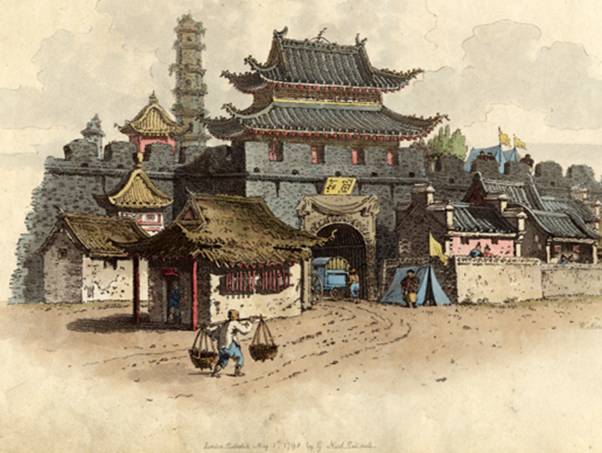
A painting of Dinghai 定海 by William Alexander in his Costume of China. London, 1805
中国服を着た、W.アレクサンダーによる定海の絵(1805)
This article is based on my presentation at the Library Panel during the Chinese Studies Association of Australia conference on 15 July 2011.
この原稿は、2011年7月15日に、オーストラリア・中国研究会の図書パネルの席での講演に基づいている。
In the presentation I used Powerpoint slides to highlight a selection of less common and sometimes unique materials which are held in closed areas of the library at Monash University and which are of interest to researchers in Chinese Studies.
この講演会で、私はパワーポイントによるスライドを用い、モナーシュ大学内部という限られた世界における、あまり世に知られていないか、ユニークなものを紹介した。
I have included some of those images in this article.
この原稿の中で、それらの中のいくつかを紹介する。
At the Asian Studies Research Collection we acquire mainstream books, journals and audiovisual materials as well as databases relating to Chinese Studies in a similar manner to other libraries with Asian language collections.
アジア研究の蒐集物においては、他のアジア研究図書館と同じように、中国研究に関するデータベースのほか、主要出版物、刊行物および音声・映像などを手に入れている。
However, what makes our collection unique, and indeed what makes other library collections unique, is the extent to which we are able to collect important and unusual materials which are not available via the usual acquisition streams.
しかしながら、私たちの蒐集物、並びに大学図書館の蒐集物をユニークなものにしているのは、それだけではなく、通常な流れの中で手に入れることができないような、重要かつふつうでない(unusual)な資料も含まれているということである。
These materials include rare books, pamphlets, films and ephemera.
これらの資料の中には、希少価値のある本、パンフレット、映像、価値が乏しいと思われる資料(ephemera)も含まれる。
Most academic libraries have some unique, rare or special materials which can be usefully described and drawn to the attention of students and researchers.
ほとんどの学術性を重んじる図書館では、学生や研究者の注意をひくような、つまり研究にそのまま役立つような、ユニークで、希少価値があるような、特別な資料を集めている。
Since such materials are not kept on the open shelves they cannot be browsed and they are not always easily discoverable from the catalogue.
これらの資料は、公開されていないため、参照したり、また簡単には目録などから、いつも知りうるものではない。
I do not want such valuable materials to be overlooked by researchers.
私はこうした価値のある資料が、研究者によって、見過ごされるのを望む者ではない。
These special materials are mainly kept in the locked areas of the Asian Studies Research Collection.
これらの特別資料は、研究資料として、アジア研究の分野に、主に、ロックされた状態で保管されている。
These collections include Special Materials Collection, the Australia Tibet Council Collection, Norodom Sihanouk Collection, Indonesian Historical Collection and Southeast Asian Pamphlets. これらの蒐集物の中には、特別資料も含まれている。
たとえば、オーストラリアーチベット会議資料、N.シアヌーク資料、インドネシア歴史コレクション、そして東南アジアパンフレット類など。
Other relevant materials are kept in the library’s Rare Books Collection.
他の関連資料は、当図書館の稀少本コレクションの中に保管されている。
Newspapers(新聞)

The Chinese Melbourne Daily 墨爾本日報.
(中国語版・メルボルン・デイリィ紙)
The newspaper’s office is in Wellington Street, Collingwood.
当新聞社の事務所は、コリングウッドのウェリングトン通りにある。
Our holdings start from 2004.
2004年から、保管を始めた。
The newspaper is periodically donated to our library by the newspaper’s proprietor.
当新聞は、新聞社の所有者から、図書館に定期的に寄付されている。
The Chinese Melbourne Daily features general news about Australia and news about Chinese communities in Australia as well as news about mainland China, Hong Kong, Taiwan and other overseas Chinese communities.
「チャニニーズ・メルボルン・デイリー」は、中国本土、香港、台湾、それに海外同胞のニュースのみならず、オーストラリア、オーストラリア内の中国人共同体のニュースなどを報道している。
The advertisements in the newspaper are an interesting reflection of ethnic Chinese life in Australia and include such categories of services as feng shui consultants.
新聞の載っている広告は、たとえば、“フェン・シュイ”コンサルタントなどのサービスを含むなど、オーストラリアにおける中国人の民族性を反映していて興味深い。
Community announcements reflect the lifestyle and observances of Chinese people and commercial advertisements record ethnic Chinese business activity in Australia.
告知板にしても、海外在住の中国人のライフスタイルを反映しているし、広告宣伝にしても、オーストラリアにおける中国人のビジネス活動を記録している。
Unlike some other papers, The Chinese Melbourne Daily is prepared to feature “sensitive” topics about China, such as Ai Weiwei’s detention and citizen protests.
ほかの新聞と異なり、“チャニーズ・メルボルン・デイリー”は、アイ・ウェイウェイの拘束やそれに対する市民の抗議など、中国における敏感な問題をも記事として提供している。
School Texts
学校のテキスト
In my presentation I described the Chinese school textbooks which we collect and which have been sought after by researchers.
今回の講演では、私たちや研究者たちによって求められた、中国で使われている教科書について説明した。
Apart from purchasing contemporary textbooks, we have been able to acquire older textbooks such as 1980s high school textbooks from Taiwan for the study of Chinese literature.
現在の教科書を購入することとは別に、中国文学の研究のため、台湾から手に入れた1980年代の高校の教科書も手に入れることができた。
They contain excerpts from classical authors with explanatory notes.
それらの中には、説明文についた古典からの抜粋文も含まれている。
They have prefatory pieces by Chiang Kaishek, Sun Yatsen, and Chiang Chingkuo.
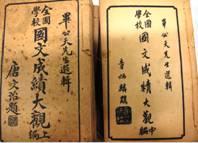
We also have school textbooks for studying Chinese literature published in 1930.
また1930年に出版された、中国文学を研究するための学校の教科書も所有している。
Astrological Almanacs.
占星・暦
There are various names in Chinese for this genre of publication including :
tong shu 通書 and min li 民曆.
中国の出版物のジャンルには、多様なものがある。
たとえば通書、民暦など。
These almanacs are an important source of traditional Chinese beliefs regarding annual events.
これらの暦を通して、年間の行事に関して、中国人の伝統的な信仰の重要な源泉を知ることができる。
It was originally an agricultural almanac but it also includes advice on geomancy (feng shui風水, kan yu 堪輿), physiognomy (xiang shu相術), auspicious naming (mingming 命名) and similar topics.
もともとは農業暦であったものだが、それらは、風水、堪輿、相術、姓名判断および類似の話題を含む。
The booklets also contain auspicious and invocatory paper strips for affixing to walls.
小冊子は、吉凶を占ったり、壁に貼り付ける紙の記念書なども含む。
In recent years the content of these almanacs have become adapted to the requirements of urban lifestyles.
近年になって、これらの暦は、都市生活のライフスタイルにも、採用されるようになってきている。
They are an important guide to how traditionally minded Chinese people lead their daily life.
それによって、伝統的なものの考え方をする中国人は日々の生活をどのように過ごすかを決める。
It is a widely purchased book and yet one not systematically collected and retained by libraries.
これらの冊子は広く購入できるものであり、図書館によって、組織的に収集されたり保持されているものではない。
Traditionally, superseded copies of the almanac are burned in temple ritual incinerators.
伝統的に、古い暦は、寺の儀式として、燃やされ、埋められる。
Almanacs can be purchased but they are also quite often published and distributed for free.
暦は、購入することもできるが、それらはしばしば、無料で印刷され、配布される。
Community Publications
共同体・出版
We hold issues of the magazine produced by a local Melbourne Taiwanese community association.
私たちはメルボルンの台湾共同体協会に発刊されている雑誌も保有している。
The magazine is a record of Taiwanese community activities in Melbourne:
その雑誌は、メルボルンにおける台湾人の活動を記録している。
Moerben Taiwan Tong Xiang Hui Hui Xun 墨爾本臺灣同鄉會會訊.
The Suetsugu Collection
「スエツグ」コレクション
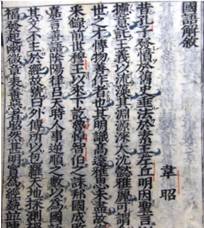
This copy of the Guo Yu 國語 was published in Osaka in 1854 and is part of the library’s Suetsugu Collection.
このコピーは、1854年に、大阪で出版された「国語」であり、当図書館のスエツグ・コレクションの一部である。
The Guo Yu consisted of historical records of states between the Western Zhou and 453 BC.
この「国語」には、西洋「Zhou」と紀元前453年の間の歴史的記録も含まれている。
This copy has Japanese annotations and punctuation which preserve a traditional interpretation and analysis of Chinese classics which would be otherwise lost.
この冊子には、日本語の注釈や句読点が付けられていて、それによって、中国の古典の伝統的な翻訳や分析を保全している。もしそうでなければ、失われていたであろう。
This and other texts are from the personal library of Mr Susumu Suetsugu of Matsue in Western Japan who donated the books to his friend Captain Shepherd of the Australian Army in the late 1970s.
この冊子および他のテキストは、西日本の松江にいたスエツグ・ススムの個人的な蔵書からのもので、1970年代の後半に、彼の友達であるオーストラリア人のシェファード大佐に寄贈されたものである。
Shepherd later donated them to Monash University Library.
後になって、シェファードは、モナーシュ大学に、これらの蔵書を寄贈した。
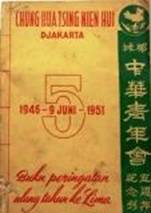
A copy of the Cai Zi Gu Wen 才子古, 文also from the Suetsugu Collection.
これはスエツグ・コレクションの一部と、その文である。
This copy was published in China in 1684.
これは1684年に、中国で出版されたものである。
At some stage it found its way to Japan .
初期の段階では、日本へも伝わった。
The Cai Zi Gu Wen was a collection of essays published during the Qing dynasty.
才子古は、Qing王朝の時代に、出版された、随筆集である。
South East Asian Pamphlets and Serials Collection
東南アジアのパフレットおよび連載物コレクション
Monash University Library acquired this large collection of nineteenth and twentieth century Indonesian and Dutch language pamphlets partly by purchases by the Asian Studies Librarian on her visits to the Netherlands in the 1960s and 1970s and partly from donations by Monash scholars who collected the publications during field trips to Southeast Asia.
モナーシュ大学は、19世紀および20世紀のインドネシアおよびオランダの膨大なコレクションを蔵しているが、一部は、アジア研究のライブラリアンにより、1960年代および1970年代に、オランダを訪問した折、購入されたものであり、また別の一部は、東南アジアを旅行した折、モナーシュの学者たちによって集められたものを、寄贈されたものである。
Most of these pamphlets are in Indonesian, Dutch, or regional languages.
これらのパンフレットのほとんどは、インドネシア語かオランダ語、もしくは地方の言語によるものである。
At present the collection is only partially catalogued.
現在、このコレクションは、部分的に、カタログ化されているにすぎない。
Many of them are unique as library materials.
それらの多くは、図書館の資料としては、ユニークなものである。
Some of them bear the names of the scholars who collected them.
それらのいくつかには、それを蒐集した学者の名前が記されている。
The collection includes publications about the Indonesian Chinese communities.
このコレクションには、インドネシアン中国人社会の出版物も含む。
There are also publications of various Chinese community organizations and studies of ethnic Chinese in Indonesia from the eighteenth to twentieth centuries.
そのほかにも、18世紀から20世紀にかけてのインドネシアにおける中国民族の共同体組織や研究に関する多様な出版物もある。
The library has other publications relating to Indonesian Chinese, including the Dutch language weekly news periodical Sin Po .
また当図書館は、週刊刊行物であるオランダ語の「Sin Po」を含む、インドネシアン中国人に関する出版物も蔵している。
This weekly was published by Indonesian Chinese and featured articles by Chinese on various topics including Chinese community affairs.
このインドネシアン中国人によって発行されている週刊刊行物は、中国人社会の事件など、広い分野の話題に関して、中国人によって記事が書かれている。
It also contains photographs of local events.
その地域のできごとの写真もまた載せられている。
Other materials in this collection relevant to Chinese Sudies inlucde Nanyang Post, a pro-Communist newspaper containing articles mainly in Indonesian but also in Chinese.
中国研究に関する、私たちが所蔵している資料には、Nanyang Post、つまりインドネシアのみならず、中国で発行された、親共産主義新聞も含まれている。
I also highlighted these pamphlets during my talk:
私は今回の講演で、このパンフレットについても、焦点をあてて述べた。
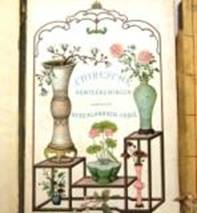
Chinesche Aanteekeningen omtrent Nederlandsch Indie. ‘sGravenhage, 1858.
(書名)
This book contains information on Chinese activities and customs around the Dutch East Indies.
この本は、オランダ領東インド周辺の中国人の活動と習慣に関する情報を含む。
It also contains Chinese language linguistic information pertaining to Indonesia.
この本はまた、中国言語のインドネシアへの浸透についての情報も含む。

Chung Hua Tsing Nien Hui. Djakarta : 1946 – 9 Juni 1951. This booklet was produced on the fifth anniversary of the establishment of the Zhonghua Qing Nian Hui 中華青年會.
(書名)
この小冊子は、第5回、中華青年会の創立祭に際して発行されたものである。
It contains articles, advertisements and photographs of the ethnic Chinese community in Jakarta.
この本は、ジャカルタにおける中国民族の原稿ならびに、宣伝と写真を含む。
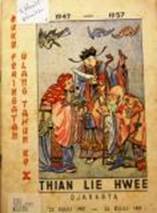
Buku Peringatan Ulang Tahun ke X, Thian Lie Hwee.[Tenth Birthday Commemorative Book of the Thian Lie Hwee]. Djakarta. 1957.
(書名)
This book in Indonesian records the activities of another community organisation, the Thian Lie Hwee.
この本は、インドネシアにおける、もうひとつの共同社会である「Thian Lie Hwee」における活動を記録している。
Indonesian Historical Collection
インドネシア・歴史的コレクション
The Indonesian Historical Collection consists of early twentieth century and pre-twentieth century books mainly in the Dutch language.
Amongst the books are many which have detailed information on the life of ethnic Chinese in the Netherlands East Indies.
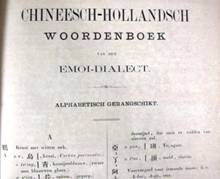
I showed images of a selection of such books in my talk.
These included the Chineesch-Hollandsch Woordenboek van het Emoi-Dialekt / J Francken. Batavia. 1882.
This is a dictionary of the Xiamen 夏門 variety of Minnanyu 閩南語.
The dictionary includes non-standard characters which are peculiar to Minnanyu.

Beschrijving van den Koan Iem Tempel “Tiao-Kak-Sie” te Cheribon / J. Ezerman. Batavia, 1919.
This book desribes a Guanyin 觀 音 temple in Ceribon in north Java.
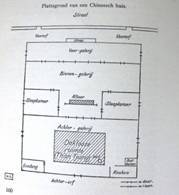
In en om de Chineesche Kamp / J. Moerman. Weltevreden, 1929.
This book was published in Weltevreden which was a new city centre for Batavia (Jakarta) built in the nineteenth century.
This book is concerned with the Chinese quarter of the city and the diagram here is of the layout of a typical Chinese house.
One needs to be able to interpret the Dutch romanisation of Minnanyu words, for example “Thian Tjiang” is the Mandarin tianjing 天井 .
Australia Tibet Council Collection
Several years ago the Australia Tibet Council donated some of their older materials to our library.
This collection contains 200 magazine titles and various videos.
Some of the videos feature Jiang Zemin’s visit to Australia in 1999 and the big pro-Tibet protest rallies.
Democracy activist Wei Jingsheng took part in the protests.
Rare Books Collection
China Illustrata by Anathasius Kircher. Amsterdam,1667.
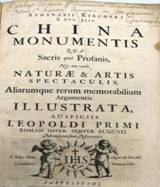
The library’s Rare Books Collection holds a wide selection of books and other materials relating to Chinese Studies.
The book in this slide China Illustrata was written by Athanasius Kircher, a seventeenth century German Jesuit scholar who was interested in Oriental Studies.
It includes a transcription of the Nestorian Stele at Chang’an (Xi’an) of 781 in Chinese and Syriac with a Latin translation by Kircher.
This is considered to be the first publication of the text of the stele in Europe.
The text discusses the Nestorian Christian clergy in China.
The book also contains a romanised list of the Chinese characters in an older type of Mandarin pronunciation.
Athanasius Kircher drew on the works of Jesuits working in China for his writings.
The full title is of the book:
Athanasii Kircheri e Soc. Jesu China monumentis quà sacris quà profanis, nec non variis naturae & artis spectaculis, aliarumque rerum memorabilium argumentis illustrata, auspiciis Leopoldi Prime, roman. imper Amstelodami, apud Joannem Janssonium a Waesberge & Elizeum Weyerstraet ,1667.
Original editions of this book sell for several thousand dollars from internet booksellers
Another important book in our Rare Books collection is the official account of the 1793 British mission to the court of the Qianlong emperor:
An abridged account of the embassy to the emperor of China, undertaken by order of the king of Great Britain : from the papers of Earl Macartney / as compiled by Sir George Staunton. London, 1797
We also have a copy of the French translation published a couple of years later: This indicates something of the wider European impact of the book:
Voyage dans l'intérieur de la Chine, et en Tartarie, fair dans les années 1792, 1793 et 1794 / par Lord Macartney ... redigés sur Les papiers de Lord Macartney sur ceux de Sir Erasme Gower ; par Sir Georges Staunton ; traduit de l'anglais ; avec des notes, par J. Castéra. Paris, 1799.
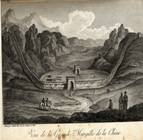
This is an illustration of the Great Wall of China in the French translation of the Macartney book.
The Macartney led to the publication of other interesting books.
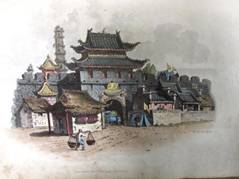
This is a painting of Dinghai 定海 (now part of Zhoushan City) by William Alexander in his Costume of China. London, 1805.
Alexander was a draughtsman on the Macartney mission.
This book contains numerous illustrations by Alexander of daily life in China. See the front of this handout for the image.

Illustration title : ”Examination of a culprit before a Mandarin”
This is also from the Costume of China.
The caption reads:
“The subject represents a female charged with prostitution.
Such an offender is generally punished publicly with a pan-tsee or bamboo. “
Missionary Books
We have a range of books by and about Christian missionaries in China.
Many of these books came from the personal library of Monash academic, the later Pete Clarke.
One of the earlier ones is:

Mrs Henrietta Shuck : the First American Female Missionary to China / by J.B. Jeter.
This biography of Henrietta Shuck (1817-1844) includes information and perceptions of China and Southeast Asia by the author based on Shuck’s personal papers.
The genre of missionary books is interesting not only for the illustrations and photographs but also for the observations of missionaries who were often close to the common people:
Childrens’ Publications
We have collected a number of Chinese childrens’ publications from the period of the Great Proletarian Cultural Revolution (1966-1976).
This genre of publication, xiao ren shu 小人书 , seems not to be something which is published anymore.
Kang Ri Xiao Ying Xiong 抗日小英雄. This is an example of the sort of materials which both reflect and contribute to anti-Japanese feelings in China.
They can be viewed alongside contemporary (and ephemeral?) Chinese web site postings which have called for boycotts and demonstrations as part of the ongoing anti-Japanese narrative in China.
The other booklets feature the theme of anti-Confucianism and the Criticise Confucius and Lin Biao campaign of the early 1970s.
These are a contrast to the position Confucius now enjoys in China.
Norodom Sihanouk Film Collection.
This is a collection of videos copied from 16mm films made by Chinese film studios of various official visits by Norodom Sihanouk to China and visits by Chinese leaders to Cambodia.
The video copies of the films, which were made by Xinhua News Agency for the King, were donated to Monash University Library by the King-Father of Cambodia Norodom Sihanouk.
The library has had many of the videos converted to DVD and the collection is being documented and inventoried for the library by Norodom Sihanouk’s official biographer and ambassador Mr Julio Jeldres who is a researcher at Monash Asia Institute.
In my presentation I selected some clips from films of the King’s visits to China dating from 1956.
Liu Shaoqi is prominent in the films (he was later purged in 1969).
The last clip is from a video cassette marked 1970.
It is not clear exactly which month in 1970.
Neither Mao nor Lin Biao is in this film but I have not viewed all the other relevant films yet.
Other films feature later visits to China by Norodom Sihanouk and visits to Cambodia by Prime Minister Zhou Enlai in 1960 and President Liu Shaoqi in 1963.
The films are an important record of the political strength of various leaders at the time of the King’s several visits and also the level of development and cityscapes of Beijing and other parts of China from the 1950s to the 1980s.
In this article I have just featured a small selection of the interesting material relating to Chinese Studies which can be found in our library.
Hiroshi Hayashi++++++++Sep 2011+++++++++はやし浩司・林浩司


<< Home